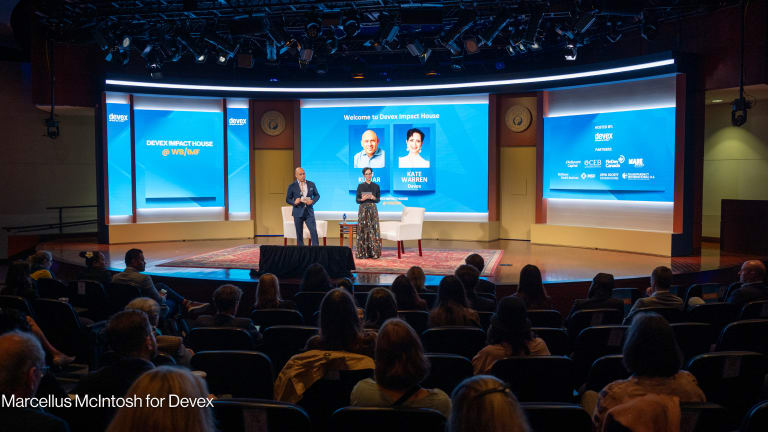
Social stock exchanges are trading platforms that allow social businesses to raise capital by attracting socially conscious investors to put money into niche capital markets. The standard definition of “social business” varies to include any that has a social, environmental or development focus. As members of the aid community, we are interested in those social businesses in our field.
SSEs represent a new instrument in the international development toolkit, bringing different actors to the fore to achieve common development goals. It is a shift in mindset where the world cares more about the actual outcomes achieved and less about who achieves them. SSEs have teetered in and out of the international development space during the last three years. They gained momentum when Grameen Bank founder Muhammad Yunus raised them during his Nobel Peace Prize acceptance speech in 2009, and more recently during his contributions to the Busannovate blog hosted by Devex last year.
So, where are these SSEs now and why should the international development community care? SSEs are relevant to different development actors for different reasons:
Reduced administrative costs. Development organizations such as the United Nations Development Program and World Bank have adopted the concept of pooling resources from multiple donors in the form of multidonor trust funds. MDTFs usually finance a program in a country or sector over many years and have generally been used in post-crisis environments to achieve quick results. They were a representation of the harmonization principles outlined in the Paris Declaration on Aid Effectiveness and the Accra Agenda for Action. Donors were content as they could still fulfill their ODA obligations while outsourcing the administrative burden to a shared trustee.
However, one shortcoming of the MDTFs was the lack of flexibility as donors were not allowed to earmark funds for specific activities or recipients. With the advent of social businesses specializing in development activities, there is a case for typical MDTF funds to be invested in specialized social businesses such as education, health in general or maternal health care in particular as part of its investment strategy. This would reduce the high administrative costs associated with lengthy due diligence and screening while still ensuring transparency, accountability and greater control for donors.
Fund diversion. U.K. Minister for Civil Society Nick Hurd recently directed 850,000 pounds ($1.3 million) to the ministry’s SSE. With Singapore, Portugal and India closely following suit, there is a possibility that governments will see better value in diverting bilateral aid dollars through this new channel if the same development outcome is achieved. ODA has been shrinking over the last decade and SSEs could yet be another outlet competing for scarce ODA money from government budgets.
The same logic applies to private capital flows to developing countries. The United Kingdom’s social investment market is currently valued at 25 billion pounds and is growing exponentially. With the country setting up its own SSE, it is plausible that this figure is likely to increase in the future.
Diversification. Traditional charities and nongovernmental organizations are now considering new business models to survive in today’s fierce economic climate. Organizations such as MicroEnsure, a microinsurance intermediary, are already discussing the idea of diversifying part of their operations into social businesses and leaving the other arm (usually research) philanthropic. With the growth of SSEs, it will be possible for existing charities that already have a strong brand name to readily raise capital from the market, reducing fundraising costs.
Private sector partnerships. After last year’s Fourth High Level Forum on Aid Effectiveness in Busan, South Korea, it is trite to say that the private sector is officially the new kid on the development block. It had its own forum agenda in Busan, which was later crystallized in the form of Clause 32 of the Busan Partnership Agreement. It is vital that the aid community leverages this formal partnership and works closely to develop new financing instruments and methods to solve development challenges.
Location, location, location. As with all things important, timing is everything. With the Singapore Social Stock Exchange set to open in June and the U.K. model in the works, there will be three operating SSEs in different parts of the globe by the end of 2013: Africa, Asia and Europe. Most aid organizations have offices spanning these regions and will benefit from this geographic dispersion.
That is not to say that all creases have been smoothed out. There remain important issues that need to be finalized such as accepted terminology, metrics and reporting guidelines for social businesses. But it is important that the aid community perceives this new platform as another avenue to achieve common development goals.
Ultimately, the takeaway from Busan last year was innovation in development. Innovative financing involves risk mitigation where risk is spread among many investors and guaranteed by higher-rated third parties. The private sector has used this model for over two centuries so maybe it is time for the development community to test it too (with some qualifiers, of course). In these challenging economic times, it is innovation through collaboration that will carry us through.
As Mark Campagnale, the founder of the U.K. SSE stated: “I would hope that the future is one where ventures from the global South that have in the past been wholly reliant on philanthropic donations will create viable, scalable businesses that are attractive to for-profit social investors in the North.”
Read more:








